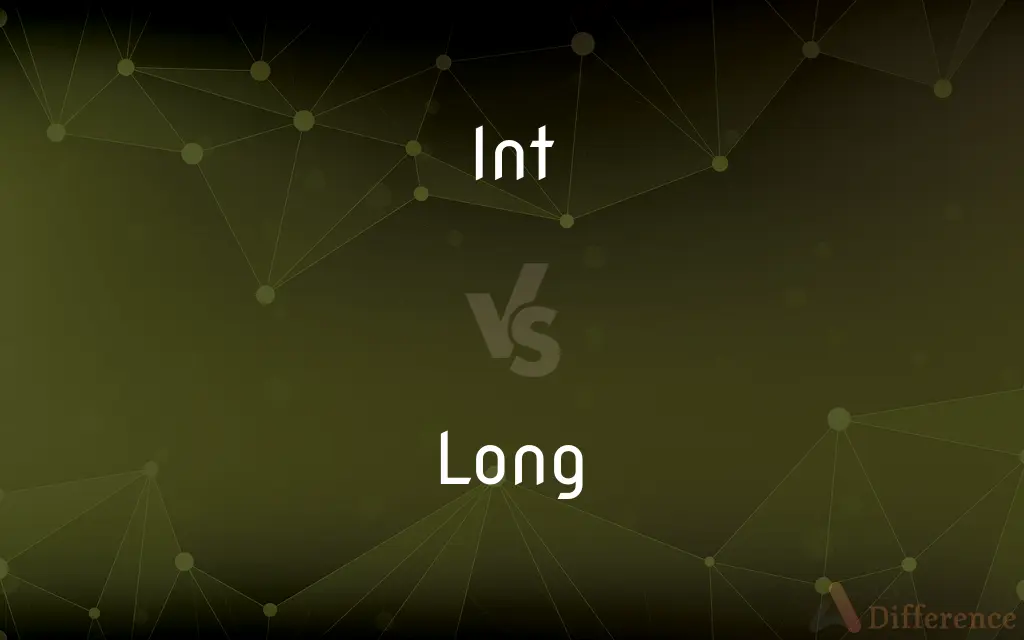Int vs. Long — What's the Difference?
By Tayyaba Rehman — Published on January 4, 2024
Int is a data type for storing 32-bit integers, suitable for smaller numbers, while Long is for 64-bit integers, accommodating much larger values.

Difference Between Int and Long
Table of Contents
ADVERTISEMENT
Key Differences
Int, short for 'integer', is a data type used in programming languages like Java and C# to store 32-bit integral numbers. Long, on the other hand, is used to store 64-bit integers, allowing for a much larger range of values.
The range of values that can be stored in an Int typically spans from -2,147,483,648 to 2,147,483,647. For Long, the range is significantly larger, from -9,223,372,036,854,775,808 to 9,223,372,036,854,775,807. This makes Long suitable for scenarios requiring representation of very large numbers.
In terms of memory usage, an Int variable consumes 4 bytes, whereas a Long variable takes up 8 bytes. This difference is crucial in situations where memory efficiency is a priority.
When programming, Int is often the default choice for integer values unless the numbers involved exceed its range. Long is used when it’s known that the integer values could exceed the Int range or when working with large datasets.
Certain programming operations, like database interactions or file handling, may require the use of Long to accommodate the possibility of very large numbers that Int cannot handle.
ADVERTISEMENT
Comparison Chart
Bit Size
32-bit
64-bit
Value Range
-2,147,483,648 to 2,147,483,647
-9,223,372,036,854,775,808 to 9,223,372,036,854,775,807
Memory Usage
4 bytes
8 bytes
Default Usage
Default for smaller integers.
Used for very large numbers.
Typical Application
General calculations, counters.
Large datasets, high-range calculations.
Compare with Definitions
Int
It’s commonly used for general-purpose programming needs.
We used an Int for the loop counter since the range was small.
Long
Long has a significantly larger range than Int.
For financial calculations involving large sums, we use Long.
Int
Int has a limited range suitable for smaller numerical operations.
The 'age' field in our application is stored as an Int.
Long
Long occupies 8 bytes of memory.
Despite the larger memory footprint, we needed Long for accurate timekeeping in milliseconds.
Int
Int is a 32-bit data type used to store integral numbers.
The variable 'count' was declared as an Int to store the number of items.
Long
Long is a 64-bit data type for storing large integral numbers.
We used a Long to store the population count of each country.
Int
Int occupies 4 bytes of memory.
We chose Int for our array to save memory, as the values were within its range.
Long
It’s essential for values exceeding the range of Int.
The database ID values are stored as Long due to their large size.
Int
It’s the go-to type for integral values in many programming languages.
For most of our calculations, we default to using Int.
Long
In scenarios requiring high-precision and large values, Long is preferred.
Calculations of astronomical distances are done using Long.
Common Curiosities
What does Long represent in programming?
Long is a data type for storing 64-bit integer values, accommodating much larger numbers than Int.
What is an Int?
An Int is a data type in programming used to store 32-bit integer values.
What is the maximum value a Long can store?
A Long can store values up to 9,223,372,036,854,775,807.
Is Int the default data type for integers in most programming languages?
Yes, in many languages, Int is the default type for integers unless specified otherwise.
Can Int and Long be used interchangeably in calculations?
They can often be used together, but care must be taken with type conversion and overflow issues.
How does memory usage differ between Int and Long?
Int uses 4 bytes of memory, while Long uses 8 bytes.
Can a Long type hold decimal values?
No, Long is used for integer values only. For decimals, types like float or double are used.
How do I choose between using Int and Long in a database?
Consider the range of values you expect to store. If they exceed the Int limit, use Long.
What happens if a value exceeds the maximum Int range?
If a value exceeds the Int range, it can lead to an overflow error unless handled or cast to Long.
When should I use Int instead of Long?
Use Int for smaller integers where the value range falls within -2,147,483,648 to 2,147,483,647.
Can I store negative values in a Long?
Yes, Long can store negative values within its range of -9,223,372,036,854,775,808 to 9,223,372,036,854,775,807.
Should I use Long for all integer variables to be safe?
Not necessarily, as using Long for smaller values can be less memory-efficient. Use Long only when large values are expected.
Are there any special considerations when using Long on a 32-bit system?
On 32-bit systems, operations with Long may be less efficient due to the larger size of the data type.
Are Int and Long types the same in all programming languages?
The concept is similar, but the exact size and behavior can vary between languages.
Is Int faster to process than Long?
Generally, Int can be processed faster due to its smaller size, especially on 32-bit systems.
Share Your Discovery

Previous Comparison
Fulltime Study vs. Part Time Study
Next Comparison
Chilli Powder vs. Ancho Chilli PowderAuthor Spotlight
Written by
Tayyaba RehmanTayyaba Rehman is a distinguished writer, currently serving as a primary contributor to askdifference.com. As a researcher in semantics and etymology, Tayyaba's passion for the complexity of languages and their distinctions has found a perfect home on the platform. Tayyaba delves into the intricacies of language, distinguishing between commonly confused words and phrases, thereby providing clarity for readers worldwide.
















































